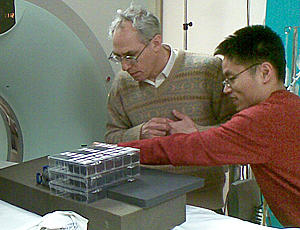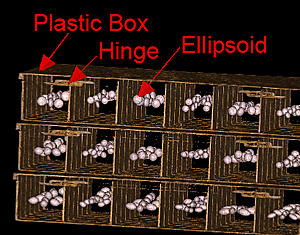
Zachary Levine (left) and Joe Chen prepare to load a boxful of polymer ellipsoids into a CT scanner to test its ability to measure lung tumor volumes.
Doctors may soon be able to diagnose lung cancer more effectively thanks to research performed at the National Institute of Standards and Technology (NIST), where scientists have found ways both to increase the accuracy of computed tomography (CT) scans and to lessen the amount of time necessary to perceive telltale changes in lung tissue.
For years, radiologists have determined the size of potentially cancerous lung nodules by measuring the largest distance across them as displayed on a computer screen in two dimensions. A method called RECIST is widely used for this purpose, but some members of the research community have suggested that three-dimensional analysis, or volumetrics, may provide a better way to determine the size of the nodules. Recently, a NIST team quantified this improvement: Volumetrics could allow physicians to notice volume changes that are up to 10 times smaller than RECIST can, potentially cutting diagnosis time from six months to four weeks—a critical difference in terms of a patient's chance of survival.
CT scans combine a series of X-ray views taken from many different angles to produce cross-sectional images of the body, but there are several approaches to interpreting scan data, so NIST's Zachary Levine set out to determine which was best by creating a set of reference objects that could mimic potential lung tumors. His team measured 283 polymer-silicate ellipsoids of precise volume that resemble pills ranging from four to 11 mm in diameter.
"For diagnosis in the earliest stage of cancer, other studies have shown this is the size of nodule you want to be looking at," says Levine.

The team encased the mimics in foam rubber and put them into layered racks of a box akin to one that holds fishing tackle. Because foam appears transparent to the CT reconstruction, in a scan the denser mimics look very much like tumors. The team was then able to compare their ellipsoids' known volumes with what the volumetrics and RECIST methods indicated from the scan data.
"We found that volumetrics allows you to notice volume changes that are a factor of 10 smaller than RECIST can with a similar level of confidence," Levine says. "This implies that you could notice life-threatening changes from a follow-up scan performed only weeks after the first, instead of months."
Levine cautions that cancers often grow in strange shapes not resembling elliptical pills which can make a diagnosis more difficult, but that the study was a good start toward improving data interpretation.
"Our work only applies to the simplest of cases, but it's still a large class of lung cancers," he says.
Z.H. Levine, B.R. Borchardt, N.J. Brandenburg, C.W. Clark, B. Muralikrishnan, C.M. Shakarji, J.J. Chen, and E.L. Siegel. RECIST vs. Volume Measurement in Medical CT Using Ellipsoids of Known Size. Optics Express, Vol. 18, Issue 8, pp. 8151–8159, 2010.

